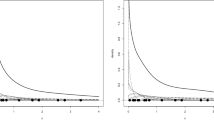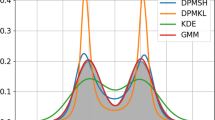Abstract
Many statistical procedures involve calculation of integrals or optimization (minimization or maximization) of some objective function. In practical implementation of these, the user often has to face specific problems such as seemingly numerical instability of the integral calculation, choices of grid points, appearance of several local minima or maxima, etc. In this paper we provide insights into these problems (why and when are they happening?), and give some guidelines of how to deal with them. Such problems are not new, neither are the ways to deal with them, but it is worthwhile to devote serious considerations to them. For a transparant and clear discussion of these issues, we focus on a particular statistical problem: nonparametric estimation of a density from a sample that contains measurement errors. The discussions and guidelines remain valid though in other contexts. In the density deconvolution setting, a kernel density estimator has been studied in detail in the literature. The estimator is consistent and fully data-driven procedures have been proposed. When implemented in practice however, the estimator can turn out to be very inaccurate if no adequate numerical procedures are used. We review the steps leading to the calculation of the estimator and in selecting parameters of the method, and discuss the various problems encountered in doing so.
Similar content being viewed by others
Explore related subjects
Discover the latest articles, news and stories from top researchers in related subjects.References
Carroll, R.J., Hall, P.: Optimal rates of convergence for deconvolving a density. J. Am. Stat. Assoc. 83, 1184–1186 (1988)
Delaigle, A., Gijbels, I.: Estimation of integrated squared density derivatives from a contaminated sample. J. Roy. Stat. Soc. B 64, 869–886 (2002)
Delaigle, A., Gijbels, I.: Bootstrap bandwidth selection in kernel density estimation from a contaminated sample. Ann. Inst. Stat. Math. 56, 19–47 (2004a)
Delaigle, A., Gijbels, I.: Practical bandwidth selection in deconvolution kernel density estimation. Comput. Stat. Data Anal. 45, 249–267 (2004b)
Delaigle, A., Hall, P.: On the optimal kernel choice for deconvolution. Stat. Probab. Lett. 76, 1594–1602 (2006)
Fan, J.: Asymptotic normality for deconvolution kernel density estimators. Sankhya A 53, 97–110 (1991a)
Fan, J.: Global behaviour of deconvolution kernel estimates. Stat. Sinica 1, 541–551 (1991b)
Fan, J.: On the optimal rates of convergence for nonparametric deconvolution problems. Ann. Stat. 19, 1257–1272 (1991c)
Fan, J.: Deconvolution with supersmooth distributions. Can. J. Stat. 20, 155–169 (1992)
Hesse, C.H.: Data-driven deconvolution. Nonparametr. Stat. 10, 343–373 (1999)
Masry, E.: Asymptotic normality for deconvolution estimators of multivariate densities of stationary processes. J. Multivar. Anal. 44, 47–68 (1993a)
Masry, E.: Strong consistency and rates for deconvolution of multivariate densities of stationary processes. Stoch. Process. Appl. 47, 53–74 (1993b)
Meister, A.: On the effect of misspecifying the error density in a deconvolution problem. Can. J. Stat. 32, 439–449 (2004)
Meister, A.: Density estimation with normal measurement error with unknown variance. Stat. Sinica 16, 195–211 (2006)
Press, W.H., Flannery, B.P., Teukolsky, S.A., Vetterling, W.T.: Numerical Recipes in C, The Art of Scientific Computing, 2nd edn. Cambridge University Press, Cambridge (1992)
Stefanski, L., Carroll, R.J.: Deconvoluting kernel density estimators. Statistics 2, 169–184 (1990)
Van Es, A.J., Uh, H.-W.: Asymptotic normality of kernel type deconvolution estimators: crossing the Cauchy boundary. Nonparametr. Stat. 16, 261–277 (2004)
Van Es, A.J., Uh, H.-W.: Asymptotic normality of kernel type deconvolution estimators. Scand. J. Stat. 32, 467–483 (2005)
Zhang, S., Karunamuni, R.: Boundary bias correction for nonparametric deconvolution. Ann. Inst. Stat. Math. 52, 612–629 (2000)
Author information
Authors and Affiliations
Corresponding author
Rights and permissions
About this article
Cite this article
Delaigle, A., Gijbels, I. Frequent problems in calculating integrals and optimizing objective functions: a case study in density deconvolution. Stat Comput 17, 349–355 (2007). https://doi.org/10.1007/s11222-007-9024-0
Received:
Accepted:
Published:
Issue Date:
DOI: https://doi.org/10.1007/s11222-007-9024-0




